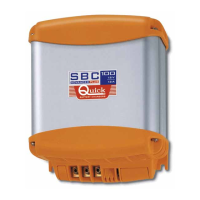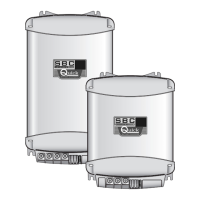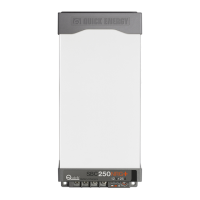Do you have a question about the Quick SBC 300 ADV PLUS FR and is the answer not in the manual?
Read manual, use on recreational crafts, fixed internal installation, child safety, warranty void.
Specifications for batteries and cables required for installation.
Guidance on choosing a suitable location for ventilation and heat dissipation.
Details on connecting the AC supply, required switch, and insulation.
Instructions for connecting batteries, including polarity checks and safety warnings.
Description of signals available on the 9-pin female D-shell connector.
Explanation of the basic state signals for monitoring the battery charger.
Guidance on connecting CAN bus using unscreened twisted pair cable, impedance, and length.
Illustrates how to connect the SBC Advanced Plus to a CAN network.
How the charger operates, IUoU characteristic, and use as a power supply.
Detailed explanation of BULK, ABSORPTION, and FLOAT charging phases.
Explanation of half-power mode activation due to low supply voltage or manual control.
Description of the control panel components: LEDs, display, and ON/STAND-BY button.
Describes issues like low AC voltage, high ambient temperature, and CAN BUS communication problems.
Details common error codes (E1-E9) related to short circuits, overloads, and overheating.
Steps to enter programming mode, including button presses and display feedback.
Optimizing charge mode for liquid electrolyte or gel batteries.
Assigning the battery charger to a specific network group (A, B, C, U).
Understanding device communication within and between network groups.
Determining the priority level of the battery charger within its network group.
Enabling or disabling the monitor mode for data transmission on the CAN network.
Annual checks for cables and electrical connections to ensure optimal performance.
Detailed data on output, input, protection, ambient, and general characteristics.
Read manual, use on recreational crafts, fixed internal installation, child safety, warranty void.
Specifications for batteries and cables required for installation.
Guidance on choosing a suitable location for ventilation and heat dissipation.
Details on connecting the AC supply, required switch, and insulation.
Instructions for connecting batteries, including polarity checks and safety warnings.
Description of signals available on the 9-pin female D-shell connector.
Explanation of the basic state signals for monitoring the battery charger.
Guidance on connecting CAN bus using unscreened twisted pair cable, impedance, and length.
Illustrates how to connect the SBC Advanced Plus to a CAN network.
How the charger operates, IUoU characteristic, and use as a power supply.
Detailed explanation of BULK, ABSORPTION, and FLOAT charging phases.
Explanation of half-power mode activation due to low supply voltage or manual control.
Description of the control panel components: LEDs, display, and ON/STAND-BY button.
Describes issues like low AC voltage, high ambient temperature, and CAN BUS communication problems.
Details common error codes (E1-E9) related to short circuits, overloads, and overheating.
Steps to enter programming mode, including button presses and display feedback.
Optimizing charge mode for liquid electrolyte or gel batteries.
Assigning the battery charger to a specific network group (A, B, C, U).
Understanding device communication within and between network groups.
Determining the priority level of the battery charger within its network group.
Enabling or disabling the monitor mode for data transmission on the CAN network.
Annual checks for cables and electrical connections to ensure optimal performance.
Detailed data on output, input, protection, ambient, and general characteristics.
| Output Voltage | 12V DC |
|---|---|
| Number of Outputs | 1 |
| Compatibility | Lead-acid, AGM, Gel |
| Protection Features | Reverse polarity, short circuit, overvoltage |
| Cooling System | Fan |












